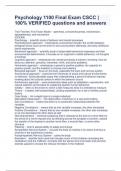Psychology 1100 Final Exam CSCC | 100% VERIFIED questions and answers Trait Theories: Five Factor Model - openness, conscientiousness, extraversion, agreeableness, and neuroticism (OCEAN) Psychology - scientific study of behavior and mental proce sses Psychodynamic approach - emphasizes unconscious thought, the conflict between biological drives (such as the drive for sex) and society's demands, and early childhood family experiences Behavioral approach - scientific study of observable behavioral responses and their environmental determinants. It focuses on an organism's visible behaviors, not thoughts or feelings Cognitive approach - emphasizes the mental processes involved in knowing: how we direct our attention, perceive, remember, think, and solve problems. Humanistic approach - emphasizes a person's positive qualities, the capacity for positive growth, and the freedom to choose one's destiny Biological approach - focus on the body, especially the brain and nervous system Sociocultural appro ach - examines the influences of social and cultural environments on behavior. Socioculturalists argue that understanding a person's behavior requires knowing about the cultural context in which the behavior occurs Evolutionary approach - uses evolutiona ry ideas such as adaptation, reproduction, and natural selection as the basis for explaining specific human behaviors Validity - refers to the extent to which a test measures what it is intended to measure Theory - a tested, well -substantiated, unifying explanation for a set of verified, proven factors Case Study - An in -depth look at a single individual. Naturalistic Observation - The observation of behavior in a real -world setting Zero Correlations - means that there is no systematic relationship between the variables Negative Correlations - means that as one variable increases, the other decreases Positive Correlations - means that as one variable increases, the other also increases, or as one decreases the ot her does as well Neurotransmitters - chemical substance that is released at the end of a nerve fiber by the arrival of a nerve impulse and, by diffusing across the synapse or junction, causes the transfer of the impulse to another nerve fiber, a muscle fi ber, or some other structure Plasticity - brain's special ability to adapt and change Sympathetic Nervous System - arouses the body to mobilize it for action and thus is involved in the experience of stress Parasympathetic Nervous System - calms the bod y Brainstem - stemlike brain area that includes much of the hindbrain (excluding the cerebellum) and the midbrain; connects with the spinal cord at its lower end and then extends upward to encase the reticular formation in the midbrain. Cerebellum - cons ists of two rounded structures thought to play important roles in motor coordination Hindbrain - located at the skull's rear, is the lowest portion of the brain. The three main parts are the medulla, cerebellum, and pons. Limbic System - A set of subcort ical brain structures central to emotion, memory, and reward processing Hippocampus - The structure in the limbic system that has a special role in the storage of memories Amygdala - An almond -shaped structure within the base of the temporal lobe that is involved in the discrimination of objects that are necessary for the organism's survival, such as appropriate food, mates, and social rivals. Hypothalamus - A small forebrain structure, located just below the thalamus, that monitors three pleasurable act ivities—eating, drinking, and sex —as well as emotion, stress, and reward Cerebral Cortex - Part of the forebrain, the outer layer of the brain, responsible for the most complex mental functions, such as thinking and planning. Four lobe - Occipital, tempo ral, frontal, parietal Motor cortex - A region in the cerebral cortex, located just behind the frontal lobes, that processes information about voluntary movement. somatosensory cortex - A region in the cerebral cortex that processes information about bod y sensations, located at the front of the parietal lobes Sensation (Bottom -up processing) - The operation in sensation and perception in which sensory receptors register information about the external environment and send it up to the brain for interpreta tion. Absolute Thresholds - The minimum amount of stimulus energy that a person can detect. Difference Thresholds - The degree of difference that must exist between two stimuli before the difference is detected. Sensory Adaptation - A change in the resp onsiveness of the sensory system based on the average level of surrounding stimulation Cones - The receptor cells in the retina that allow for color perception Trichromatic Theory - Theory stating that color perception is produced by three types of cone receptors in the retina that are particularly sensitive to different, but overlapping, ranges of wavelengths. Opponent Process Theory - Theory stating that cells in the visual system respond to complementary pairs of red -green and blue -yellow colors; a gi ven cell might be excited by red and inhibited by green, whereas another cell might be excited by yellow and inhibited by blue. Hearing - mechanoreception, detection of vibration Kinesthetic - Senses that provide information about movement, posture, and orientation. Vestibular - Sense that provides information about balance and movement. Smell - chemoreception, detection of chemical stimuli Taste - chemoreception, detection of chemical stimul i




